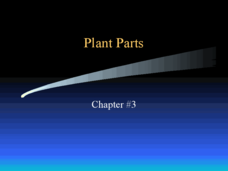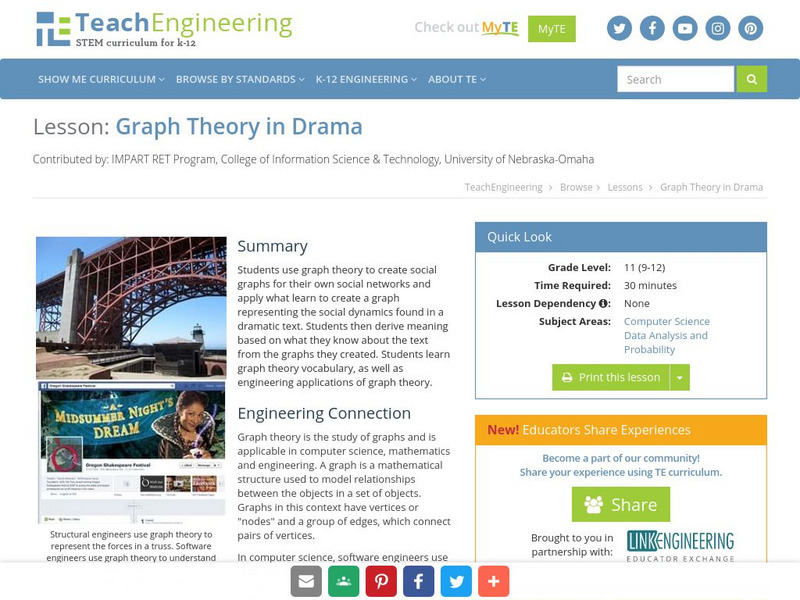Curated OER
Standing Waves
In this waves activity, students learn about standing waves and harmonics. Then students complete 11 matching, 15 fill in the blank, and 7 short answer questions.
Curated OER
Plant Parts Chapter #3
A few diagrams and bullet-point notes fill the 24 slides of this presentation on plant parts. The content is advanced enough for high school or college botany courses. The diagrams, however, are of substandard quality and quantity. You...
TeachEngineering
Teach Engineering: Using Graph Theory to Analyze Drama
Students analyze dramatic works using graph theory. They gather data, record it in Microsoft Excel and use Cytoscape (a free, downloadable application) to generate graphs that visually illustrate the key characters (nodes) and...
TeachEngineering
Teach Engineering: Making the Connection
Graph theory is a visual way to represent relationships between objects. One of the simplest uses of graph theory is a family tree that shows how different people are related. Another application is social networks like Facebook, where a...
TeachEngineering
Teach Engineering: Graph Theory in Drama
Students use graph theory to create social graphs for their own social networks and apply what learn to create a graph representing the social dynamics found in a dramatic text. Students then derive meaning based on what they know about...
Physics Classroom
The Physics Classroom: Nodes and Antinodes
In this thorough lesson, nodes and antinodes are explained and compared to crests and troughs. A "Check Your Understanding," set of questions is included at the end of the lesson with answers.
Physics Classroom
The Physics Classroom: Light Waves and Color
The behavior of light waves is introduced and discussed. Also, polarization, color, diffraction, and interference are introduced and discussed thoroughly as supporting evidence of the wave nature of light.
Other
Greg Freeman: Brainstorming Web
Greg Freeman gives an example and explanation of the graphic diagram called "brainstorming web." Includes suggestions for effective use, working strategies, and useful links.
Physics Classroom
The Physics Classroom: Two Point Source Interference
This lesson from the Glenbrook South High School discusses two-point source interference. It gives detail on the difference between constructive and destructive interference, what a two-point source interference is and what happens when...
NASA
Nasa: Eclipses
The periodicity and recurrance of eclipses is governed by the Saros cycle, a period of approximately 6,585.3 days (18 years 11 days 8 hours). It was known to the Chaldeans as a period when lunar eclipses seem to repeat themselves, but...
Physics Classroom
The Physics Classroom: Light Waves and Color: The Path Difference
After looking at a representative two-point source interference pattern with accompanying order numbers, students investigate the rationale behind the numbering system, and develop some mathematical equations that relate the features of...
Physics Classroom
The Physics Classroom: Second Harmonic: Standing Waves on a String
A reference page that includes content and an animation to explain standing waves, nodes, and harmonics.
Khan Academy
Khan Academy: What Are 3 D Shapes?
This Khan article explains how to write your own 3D graphics engine with some trigonometry!










